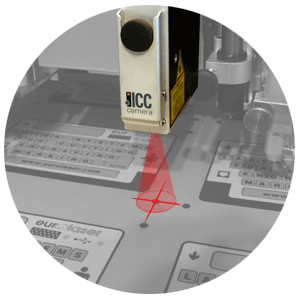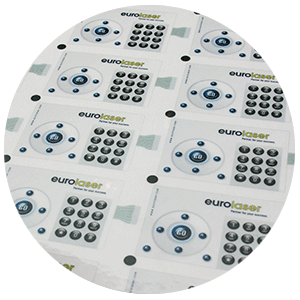Further CO2 laser cutter for the processing of plastic foils

The demand for quality and reliability in respect of the keyboard elements is high, and continues to increase. Keyboards must be permanently usable under a particular set of conditions and must overcome external influences such as humidity or soiling. Flexibility combined with ease of cleaning and a high level of resilience are decisive criteria, which it pays to meet. This creates ever increasing demands on manufacturers and the processing industry. The extensive range of products and ever shorter delivery times mean that calls for simpler production methods are getting louder all the time.
This is where laser cutting comes into its own:
- No chipping of material as can happen in punching
- Requires no knife cleaning, no adhesion of individual parts
- No humidity as in water jet cutting
- Sealed cutting edges
Punch, water jet and knife - are they still the most effective production methods?
Punching continues to be the quickest way of shaping foil products. Depending on the value of the product, punching tools for medium and large series can be deployed very cost-effectively. But how productive is punching when it comes to individualised products or small series? In this case, the expensive production of a punching tool drives the cost and makes production non-viable. The same applies if immediate delivery is required and if it is a question of individually varying product characteristics. In this case, the punching tool cannot produce effectively.
Water jet cutting, by contrast, quickly reaches its limits when it comes to precision cutting. What is more, soiling and a high level of humidity on the material to be processed are natural consequences of using water.
Compared to punching tools and water jet technology, knives are subject to rapid wear and tear and consistency of quality falls by the wayside. Follow-on costs for replacing tools and the down time associated with this are unavoidable.

What decisive difference does laser cutting offer?
Non-contact! Laser jet processing is contact free. This characteristic alone offers many advantages. Foil remnants cannot adhere to the tool, the material does not need to be fixed in place and there is no danger of squashing or chipping, even if the foil is multi-layered. The thermal process can cause the cut edges to melt, which also acts as a kind of sealing. This creates an automatic protection against soiling without additional expense.

In recent years, the level of automation has also increased significantly. Printed foils for fronts or particular functions can also be precisely recognised and outlined by means of an interactive optical recognition system. In order to automate still further the production of high quality keyboards, laser systems are often stocked with foil by a robot. Here, too, the position of the foil sheet is identified by camera recognition and it is cut precisely. The keyboards are then collected by the automatic handling system and separated from the remainder of the foil sheet. This fully automated process means that production can continue around the clock and the full potential of the laser cutter be exploited. Human beings have a purely supervisory function.

Developments in recent years mean that laser technology has become a real competitor for conventional processing methods, even when dealing with large quantities. A very high level of precision and the almost maintenance-free ‘laser’ tool have now convinced many companies that are daring to move towards this technology. Anyone who wants to survive the pressure of competition nowadays must employ innovative planning processes and production methods. In practice, however, implementation is not always simple. Without flexible technologies and automation processes new innovations in the sector cannot be implemented in a viable manner. Laser technology makes many things economically viable - both today and in the future.
For further information please click the links below:
Do you have any questions? We are pleased to advise you.




